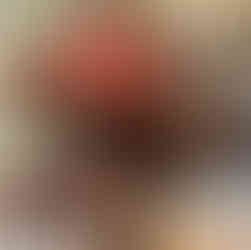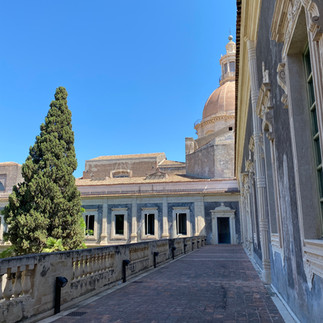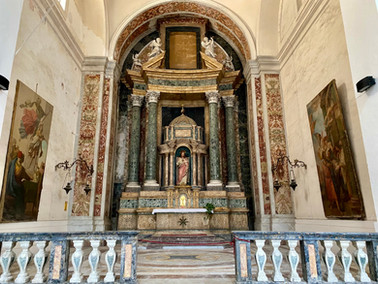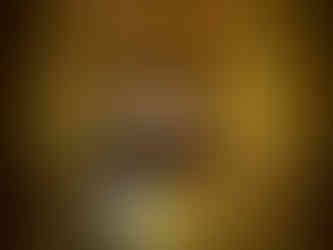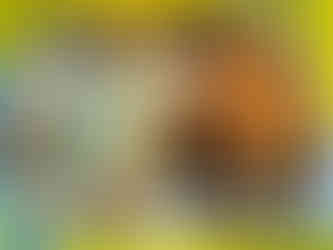What to see in Catania, Sicily - a historic walking tour
- Jenny Feleciano
- Jun 29, 2025
- 12 min read
If you only have one day in Catania, Sicily and want to know the best things to see, this self-guided walking tour is the perfect itinerary! Discover the history of underground rivers and volcanic eruptions, tour a medieval castle and a Roman amphitheater, walk in the footsteps of Catania’s martyred patron saint, immerse yourself in the city’s food culture, and indulge in traditional Sicilian desserts and street food.

You could easily spend several days exploring Catania and its history; however, if you’re short on time or need an itinerary for a one-day walking tour, then read on!
Don't have time to read the whole article? Jump to any section!
Self-guided tour of Catania: stops in order
Monastero dei Benedettini di San Nicolò l’Arena (Benedictine Monastery)
Chiesa di Sant’Agata al Carcere (Church of Saint Agatha’s Incarceration)
Piazza Stesicoro (historic city square with a metro station)
Villa Bellini (city park with walking paths, gardens, and statues)
Chiesa della Badia di Sant'Agata (Abbey Church of Saint Agatha)
Are you ready to explore Catania? Here are the best stops for your very own self-guided tour!
The best place to begin any visit to Catania is Piazza del Duomo, also known as Elephant Square in English, or “u Liotru” in Sicilian.
1. Piazza del Duomo (Elephant Square)
Piazza del Duomo is the heartbeat of the city’s historic center. The centerpiece of the square is Fuente del Elefante, a tall monument featuring an elephant statue carved from black basalt. One of the most prominent features of the smaller-than-usual elephant is the disproportionately large body part between the elephant’s back legs.

Fuel up for the morning at one of the cafes situated around this beautiful piazza. The most popular is Prestipino, which offers coffee and pastries, as well as a variety of traditional Sicilian cakes and other sweets. For a true Sicilian breakfast, order granita con brioche. Granita is a semi-frozen treat, usually dairy-free, and flavored with sugar and natural juices. In Sicily, granita is served with a brioche roll, and any local will tell you that you can tell a person’s character based on how they eat their granita con brioche. For all the best foods to eat in Sicily, read this!
Baroque architecture can be found throughout Catania’s historic center, and it is on full display at the Cattedrale di Sant'Agata, named after the city’s patron saint. Originally constructed in the late 11th century, the cathedral has survived multiple volcanic eruptions from nearby Mt. Etna, a fire and an earthquake in 1169, and another earthquake in 1693, after which it was rebuilt in the Baroque style.

Underneath the cathedral is Terme Achilliane, an archaeological site featuring the excavated ruins of an ancient Roman thermal bath complex. The entrance is outside the front entrance, down a set of stairs on the right side if you’re facing the church. You can buy tickets in a little shop a few doors down, heading towards the stone archway.

Diagonal from the cathedral is the Palazzo degli Elefanti, a 17th century palace used as the current city hall. If the gates in the front of the building are open, take a look inside to see the official carriage used in the Festa di Sant’Agata procession, as well as displays that explain the history of the festival. Check this out to read more about Catania’s patron saint and how to experience the festival dedicated to her.

Opposite of the Palazzo degli Elefanti is the Fontana dell’Amenano, a fountain depicting mythical figures and inscribed with the city's coat of arms. An underground river flows beneath Catania, encased by volcanic eruptions and earthquakes over time. This fountain is one of the few places in the city where Catania's secret river reveals itself!

2. Pescheria di Catania (Catania Fish market)
Just down the steps behind the Fontana dell’Amenano, you’ll find yourself on a terrace overlooking Pescheria di Catania, the city’s colorful and lively fish market. I guarantee this is one of the most memorable things you’ll experience here, so make sure you have closed-toed shoes on, and get ready for total sensory overload - the sights, sounds, and smells of every type of fresh seafood you can imagine, complete with heads, eyeballs, and guts.
Don’t be shy, a walk through the maze of vendors is all part of the experience, with fishmongers calling out to offer you samples, bantering with their neighbors as they jokingly throw insults at each other in Sicilian, and chopping off the heads of fish right in front of you. This daily market has been a way of life in Catania for hundreds of years, and it is total chaos in all its glory!
Wander through the streets and alleyways in the vicinity to discover fresh fruit and vegetable markets, meat and cheese vendors, pasta and wine shops, and street food stands. This is a great time to stop for an early lunch or snack at one of the restaurants on the terrace above the market, or along one of the side streets.
Scirocco Sicilian Fish Lab is a perfect place to grab a quick bite, just walk up to the counter to order and sit at one of the outdoor tables or take your calamari fritti to-go in a paper cone. For a sit-down meal, stroll around the corner to Via Gisira, also known as Le strade degli ombrelli (the umbrella street).

Before your next stop, check out the Fontana dei Sette Canali (Fountain of the Seven Canals) at the bottom of the steps leading from the terrace down into the market. Built in 1612, it’s one of the oldest fountains in Catania and is another place you can see the city's underground river.

3. Castello Ursino (Ursino Castle)
Ursino Castle served as a coastal fortress during the 12th century Norman rule of Sicily. However, the massive eruption of Mt. Etna in 1669 created a lava flow from the volcano down to Catania and out into the sea, thereby extending the city’s coastline further into the water. Even today, you can still see large pieces of lava stone protruding from the ground surrounding the castle.

Ursino Castle is now a civic museum, showcasing a royal archaeological collection, religious artifacts, and artwork. At the time of this article the museum was temporarily closed for renovations, so I suggest that you check the official website before planning your visit. However, the views of the outside of the castle are worth the short walk from the Fish Market.
This stop offers you the chance to experience a Sicilian Chiosco, an open-air bar usually found in parks or piazzas that serves a variety of drinks and small snacks. The Chisco Bar In68 is just across Piazza Federico di Svevia from Ursino Castle, and is a great place to get a mid-morning coffee or try a Seltz Limone e Sale, a drink made with fresh lemon juice, seltzer water and salt, traditionally popular on hot days.

Another option for a meal or snack at this point is A Putia Dell’Ostello, which you can find on the map route at the end of this article. A Putia is a fun restaurant with tables along the underground river (they should be reserved in advance). They also have tables at street level, and it’s a wonderful place to relax with food or cocktails any time of day.

4. Teatro Antico Greco-Romano (Greek - Roman theater)
Dating back to the 2nd century, Catania's Greek-Roman Theater is tucked away within the city so well that you might walk right by if you weren’t looking for it! In addition to the open-air amphitheater there is also an Odeon, which was a smaller, roofed structure intended for musical performances. One of the most unique features of this site is that it is built partially out of lava stone, which was taken directly from the lava that flowed into Catania from Mt. Etna.

5. Via Crociferi
This picturesque street in the heart of Catania is a masterpiece of Baroque-style buildings, including churches, monasteries and palaces from the 18th century. The Arco di San Benedetto (Arch of Saint Benedict) is near the beginning of the street, just after you turn onto it from Via Vittorio Emanuele II, and connects the Church of San Benedetto to the monastery by the same name.
Be sure to stop in the small piazza before the arch, to admire the church dedicated to Saint Francis of Assisi and the birthplace of opera composer Vincenzo Bellini. After you pass under the arch and continue down the street, you’ll find the Church of San Francesco Borgia, the Church of San Giuliano and the Church of San Camillus.

6. Monastero dei Benedettini di San Nicolò l’Arena (Benedictine Monastery)
A UNESCO World Heritage Site featuring lava stone construction, this former monastery is now used by the University of Catania. Wander through the halls, cloisters and gardens on your own, or take a guided tour to learn even more about the history of the monastery and the city of Catania.

Alongside the Monastero dei Benedettini di San Nicolò l’Arena is the Chiesa di San Nicolò l’Arena. One of the most noticeable features of this church is that the façade is unfinished, revealing medieval lava stone construction from before the earthquake of 1693. The inside is simple but massive, and features many frescoes and other pieces of art, as well as a World War II memorial and a 37 meter-long sundial on the floor.
Although the inside of the church is beautiful, the real show stopper is the rooftop tour. For just a few Euro and a “few” steps up a circular stone staircase, you’ll be rewarded with 360 degree views of the entire city, and an incredible view of Mt. Etna!
7. Chiesa di Sant’Agata al Carcere (Church of Saint Agatha’s Incarceration)
The Chiesa di Sant’Agata al Carcere is a small church dedicated to the imprisonment of Catania’s beloved patron saint, Agatha, who was martyred for refusing to marry someone of importance in the city. As punishment, she was imprisoned and tortured, including having her breasts cut off and then being burned alive on a grill. In the back of the church, you can visit the cell where legend says Agatha was imprisoned. Locals sometimes light candles or leave flowers underneath the window of the cell, especially during the annual festival dedicated to her. Learn more about St. Agatha’s tragic story in this article about the festival held in her honor each year.
8. Piazza Stesicoro
Piazza Stesicoro is a popular place for many locals, where you can usually find street food stands and people meeting for coffee or drinks. A place of historical significance, Piazza Stesicoro is the archaeological site of a Roman Amphitheater (Anfiteatro Romano di Catania) that was built around 300 BC.

It is also believed that this is the location of St. Agatha being “grilled” on a bed of hot irons. For this reason, the church here, Chiesa San Biagio in Sant’Agata alla Fornace, is dedicated to Agatha’s torture and death.

If you’re looking for a sit-down meal at this point, you can try Al Vicolo Pizza & Vino or wander through the neighborhood between Piazza Stesicoro and the San Berillo Art District (#10 on this list).
If you’re short on time, you can cut out stops #9 through #12 and end the tour here. To get back to Piazza Borsellino, walk down Via Etnea towards Elephant Square, through the stone arch, and across the park. To get back to Stazione Centrale, you can take the metro there from the Piazza Stesicoro station. For everything you need to know about using public transportation in Catania, check this out.
9. Villa Bellini
For a relaxing break or a quick snack, walk up Via Etnea to Villa Bellini, a beautiful city park with gardens, trees, fountains, paths with inlaid lava stone designs, and benches. There is a small Chiosco bar near the entrance to the park and two cafes across the street, Bar Pasticceria Spinella and Pasticceria Savia. Try a Cipollina from Savia (a light and flaky puff pastry with ham, cheese, onions and tomato inside) or an Arancino from Spinella (savory, stuffed rice balls that are coated in breadcrumbs and deep fried).

If those items don’t spark your interest, not to worry, both of these places have plenty of other pastries, snacks and sweets to tempt you. Cool off with a granita or spritz, or satisfy your sweet tooth with a cannolo or cassata! For all the best foods to eat in Sicily, read this!
10. San Berillo Quartiere (San Berillo Art District)
Historically the “red light district” of Catania, the San Berillo Art District is now home to colorful murals and funky art displays. Wander its narrow alleyways to discover the neighborhood’s local art and culture and soak in its Bohemian vibes. This is a great area to come back to for dinner if time allows; my favorite restaurant is La Pentolaccia (reservations are highly recommended).
11. Teatro Massimo Bellini (Bellini Opera House)
The Bellini Opera House, named after opera composer Vincenzo Bellini, sits as the centerpiece of the piazza named after him. Situated around the piazza are impressive government buildings, also built in the Baroque style, that offer a picturesque backdrop for an afternoon coffee or cocktail at Caffè Opera or one of the other cafes here.

12. Chiesa della Badia di Sant'Agata
If you time your walking tour correctly, you’ll end up at Chiesa della Badia di Sant’Agata just before sunset. This small but beautiful 18th century church was built on the grounds of a Benedictine abbey, and offers spectacular views of Mt. Etna from its dome. Enjoy the sunset from its rooftop for a perfect ending to your day in Catania!
Recap of where to eat and drink along the route
Elephant Square: Prestipino (gelato, granita, pastries, drinks and sweets)
Fish market: Scirocco Sicilian Fish Lab (fried fish and seafood)
Fish Market: Le strade degli ombrelli (seafood restaurants with overhead umbrellas)
Piazza Currò: A Putia Dell’Ostello (cocktail bar and “underground” restaurant)
Piazza Federico di Svevia: Chisco Bar In68 (open-air drinks and snacks)
Piazza Stesicoro area: Al Vicolo Pizza & Vino (pizza and wine bar)
Villa Bellini: Pasticceria Savia or Bar Pasticceria Spinella (local specialties & sweets)
San Berillo District: La Pentolaccia (restaurant with traditional Sicilian dishes)
Piazza Bellini: Caffè Opera (coffee, pastries and light sandwiches)
Google map of the route
How to get to Catania
Public transportation:
If you are staying outside of Catania and want to use public transportation, you can arrive either by bus or train. If traveling by bus, you’ll want to arrive at Piazza Borsellino as opposed to Catania Centrale. Piazza Borsellino is an easy five-minute walk to Piazza del Duomo, while the walk from Stazione Centrale takes about 20 minutes and includes walking across the most chaotic roundabout I’ve ever experienced. I use the term “roundabout” loosely here, as there is no central median, which makes it more of a “free-for-all” in my opinion.
If traveling by train, you’ll have no choice but to arrive at Catania Centrale. If you don’t want to walk from here, you can take a local bus to Piazza del Duomo or Piazza Borsellino. For links to local bus information and everything else you need to know about using public transportation in Catania, check this article out.
Driving a car:
For those brave souls driving a personal or rental vehicle, the closest paid parking lot is Parcheggio Borsellino, which is the same location as the Piazza Borsellino bus stop. I recommend that you arrive early in the morning for the best chance of getting a parking spot, as many people park here in order to take buses out of Catania, as well as to visit the daily market nearby. When you pull into the parking lot, you’ll go through a gate where you get a ticket from a machine. Keep the ticket and pay at one of the payment machines in the center of the lot before you leave, as you’ll need to put your receipt into the machine at the exit gate.
If you can’t find a spot at Parcheggio Borsellino, you’ll need to drive around a bit to find street parking. If this happens, just be patient and try to work your way around in an expanding circular pattern. Pay attention to the colored lines on the street. White lines mean free parking, while blue lines mean paid parking. For detailed parking rules and more tips on driving in Sicily, read this article.
If you enjoyed this, drop me a comment below! Check out some of the other articles on my European Destinations page or read more about my Sicilian adventures below!














